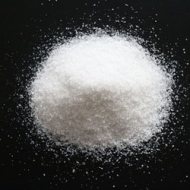Products Description of Cationic polyacrylamide(CPAM)
White powder flocculant Cationic polyacrylamide(CPAM) for waste water treatment
Cationic polyacrylamide(CPAM),PAM, is a water-soluble organic high molecular weight polymer, has unique effect to increase the viscosity of water or to promote the flocculation of particles present in water, it can also reduce the frictional resistance between the liquid.
As a flocculant, it is widely used in many fileds like Oil Exploration , Water Treatment , Paper Making,Sludge Dewatering, Textile, Sugar Making, Coal washing and Incense Making, etc. According to the different ion characteristics, PAM has three types: Cationic PAM, Anionic PAM, and Nonionic PAM.
Physical and Chemical Properties:
Chemical Name: Polyacrylamide
Appearance: White to off-white Crystalline Granular. Molecular Formula: C3H5NO Formula Weight: 71.0779 CAS No. 9003-05-8
what is the difference of Anionic polyacrylamide and cationic polyacrylamide?
Anionic polyacrylamide and cationic polyacrylamide are two types of polyacrylamide polymers with different ionic charges.
Anionic polyacrylamide (APAM) has a negative charge, and it is mainly used as a flocculant and coagulant in wastewater treatment, mineral processing, papermaking, and oil recovery. APAM can effectively remove suspended solids, organic matter, and other impurities from water or wastewater by adsorption and bridging.
Cationic polyacrylamide (CPAM) has a positive charge and is commonly used as a coagulant aid, flocculant, and sludge dewatering agent in water treatment processes. CPAM can neutralize the negative charge of colloidal particles in wastewater and form flocs through charge attraction, leading to efficient solid-liquid separation
Specification of Cationic polyacrylamide (CPAM )
No. | Test item | unit | Technical standard | Test result |
1 | Appearance |
| White powder | White powder |
2 | Solid content | % | >88% | 90.8 |
3 | Cationic degree | % | 5-95 | 42.5 |
4 | Acrylamide monomer content | % | ≤0.1 | 0.06 |
5 | Dissolution time | min | ≤60 | 51 |
6 | Water insoluble | % | ≤0.3 | 0.21 |
7 | Chloride content | g/g | ≤0.05 | <0.05 |
8 | SO4 content | g/g |
≤0.05
| <0.05 |
Product packaging
In 25kg craft paper bag or 750kg big bag. 20-21mt/20'fcl on pallet.
Polyacrylamide uses (Usage Instructions for Polyacrylamide)
1,Polyacrylamide flocculants should not be directly added to wastewater. Prior to use, they must be dissolved in water and the resulting solution used for treating wastewater.
2,The water used to dissolve the polymer should be clean (e.g., tap water) and not wastewater. Room temperature water is suitable; generally, heating is not necessary. Dissolution is slow at temperatures below 5°C. While increasing the water temperature speeds up dissolution, temperatures above 40°C can accelerate polymer degradation, affecting performance. Tap water is generally suitable for preparing polymer solutions. Strong acids, strong bases, and highly saline water are not suitable for preparation.
3,The recommended concentration range for polymer solution is 0.1% to 0.3%, i.e., adding 1-3 grams of polymer powder to 1 liter of water. Concentration selection should consider the following factors:
. For small preparation tanks with a high daily dosage, a slightly higher concentration (e.g., 0.3%) is recommended.
. When the polymer has a high molecular weight, a slightly lower concentration (e.g., 0.1%) is suggested.
. If dispersion is poor when adding the polymer solution to wastewater due to equipment limitations, a slightly lower concentration is advised.
. In general, excessive polymer concentration can overload the mixer motor and lead to poor dispersion when introduced into wastewater, affecting effectiveness.
4,Do not transfer prepared solutions using a centrifugal pump to avoid shear degradation of the polymer caused by high-speed blade rotation. The specific preparation method is as follows:
. Add a certain amount of clean water to a container (e.g., laboratory beaker, mixing tank).
. Calculate the required amount of polymer powder based on water volume and desired concentration, then weigh the polymer.
. Start the electric mixer and create a vortex in the water. Ensure that the linear velocity at the tip of the mixer blade does not exceed 8 meters/second to prevent polymer degradation. However, the speed should not be too slow, preventing polymer particles from floating or sinking in the water.
. Slowly sprinkle the polymer powder into the vortex until fully dispersed. Ensure that polymer particles do not agglomerate or clump together.
. Continue stirring for a specified time until the polymer particles are fully dissolved, resulting in a uniform, transparent, and viscous solution without visible clumps. Stirring times are determined as follows:
A: In warmer seasons, for cationic and anionic polymers, stir for approximately 1 hour; for non-ionic polymers, stir for about 2 hours.
B: In colder seasons, for cationic and anionic polymers, stir for approximately 1.5 hours; for non-ionic polymers, stir for about 3 hours.
Note: Iron ions catalyze the chemical degradation of all polyacrylamides. Therefore, during preparation, transfer, and storage of polyacrylamide solutions, minimize the introduction of iron ions. Equipment in contact with the solution is best made from stainless steel, plastic, fiberglass, or carbon steel with a resin coating.
if you need other details of polyacrylamide : like the MSDS ,COA ,TDS , contact us directly .

